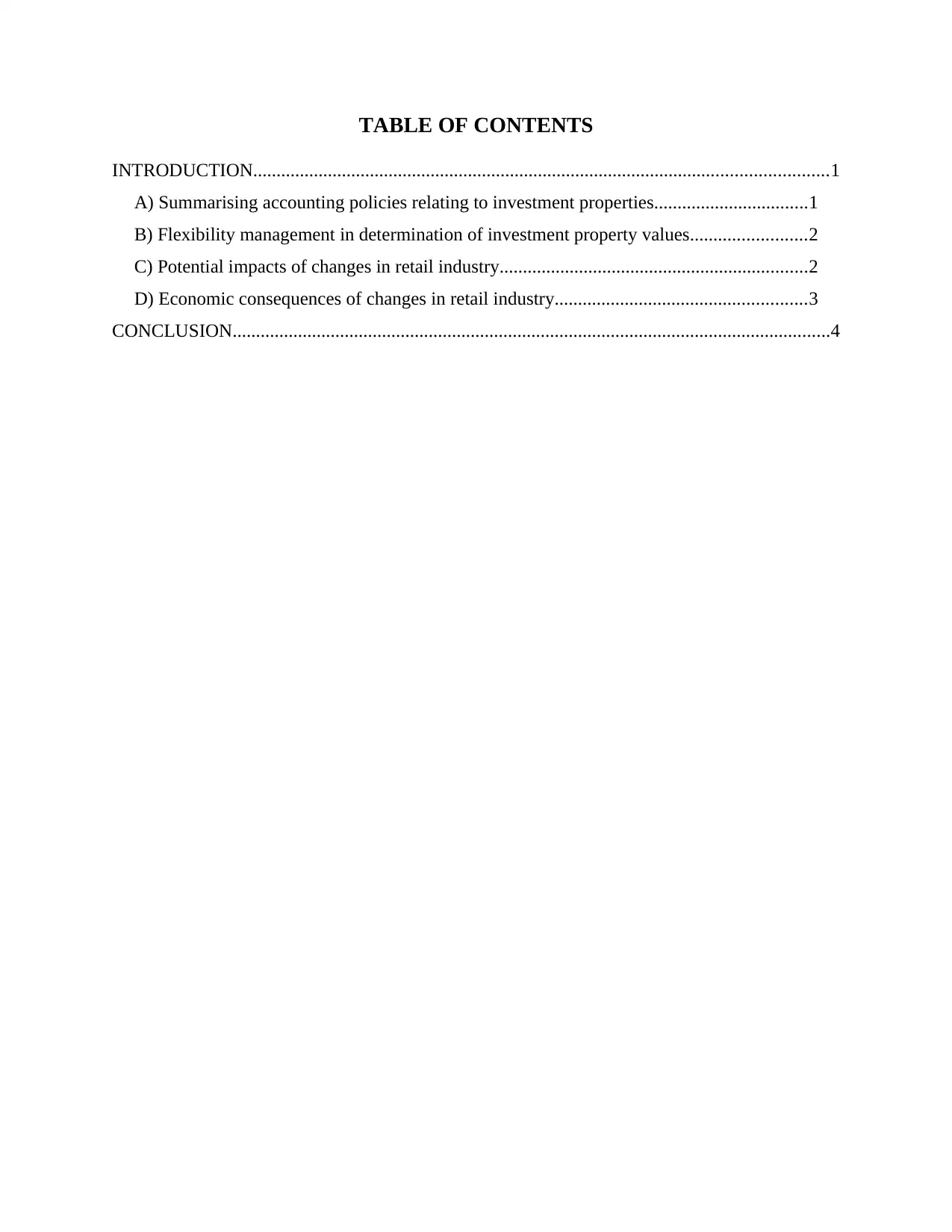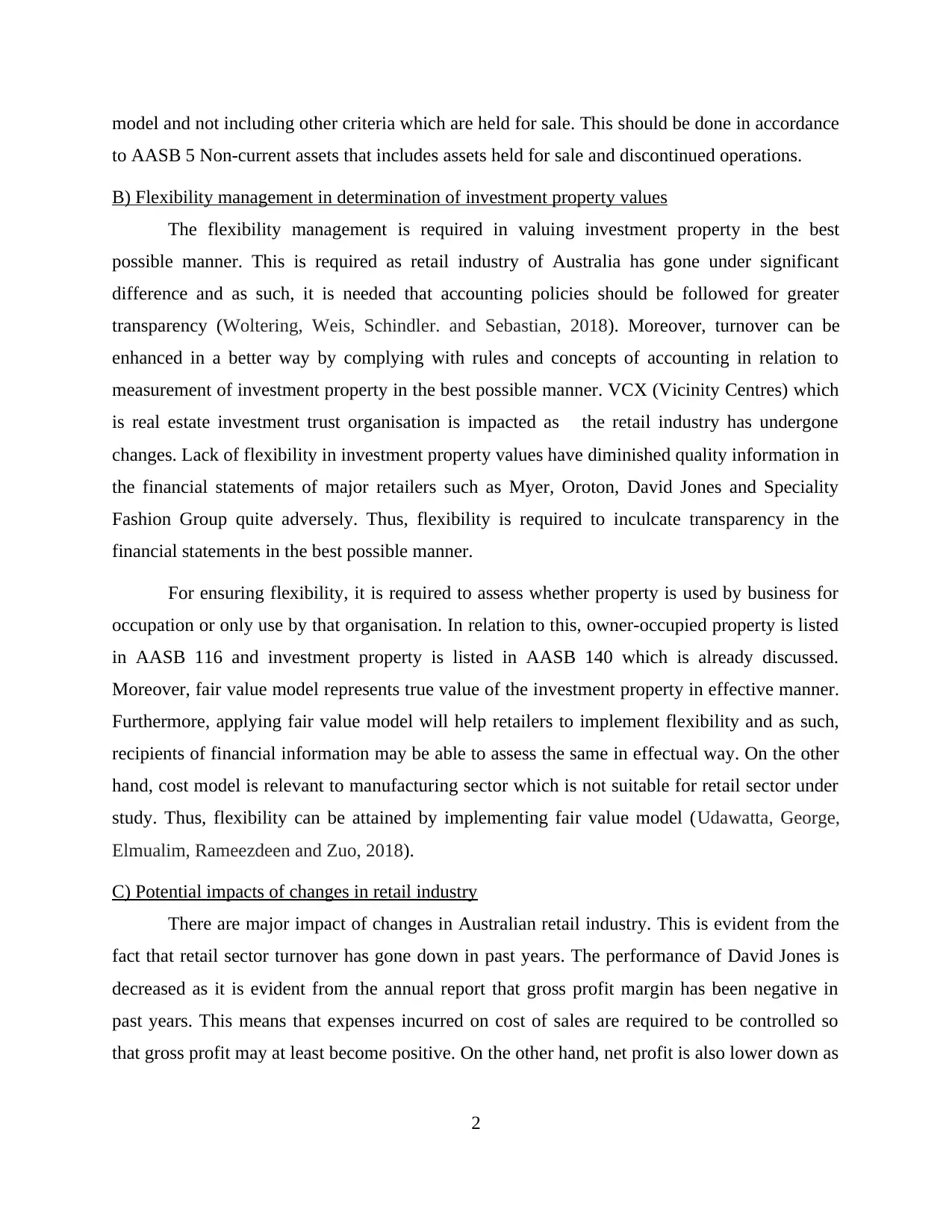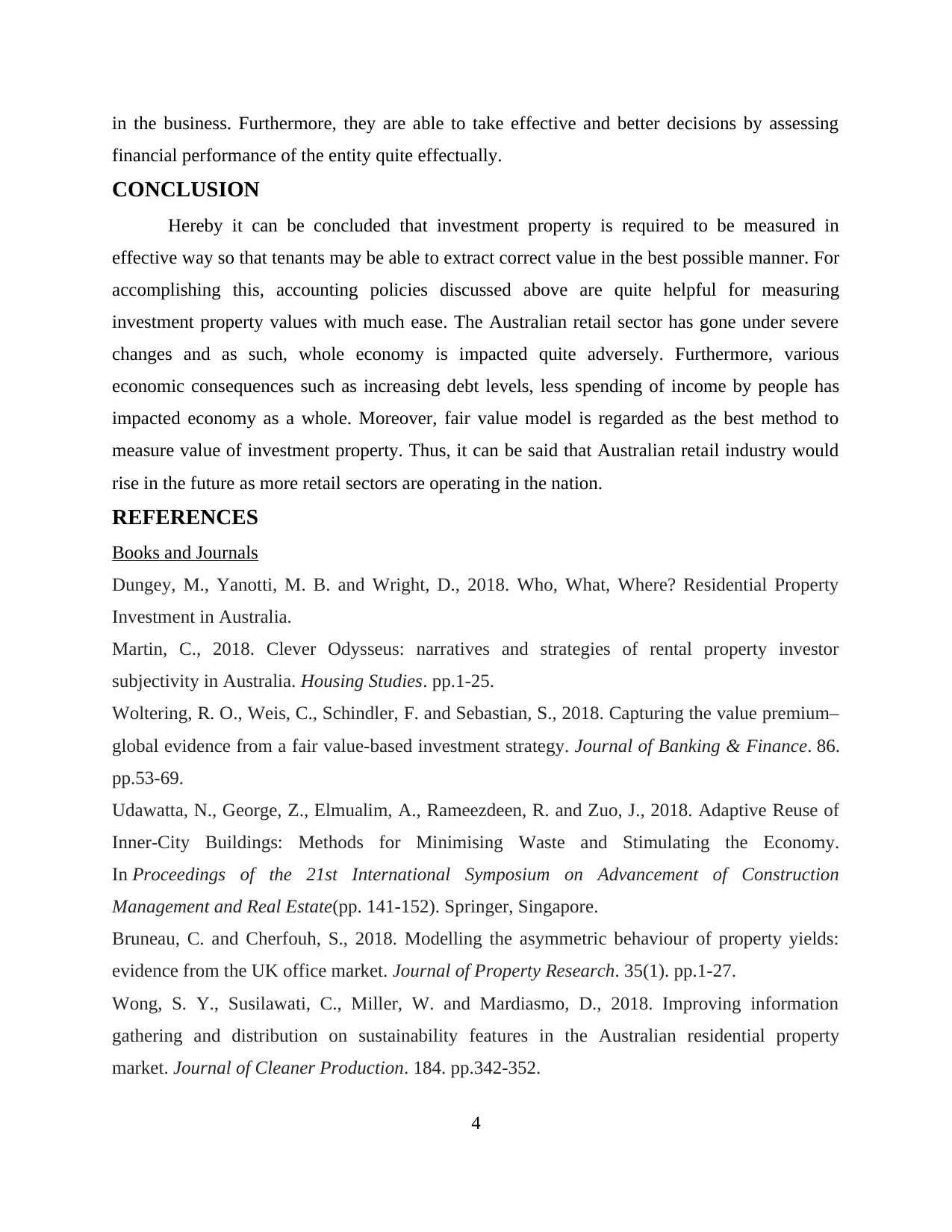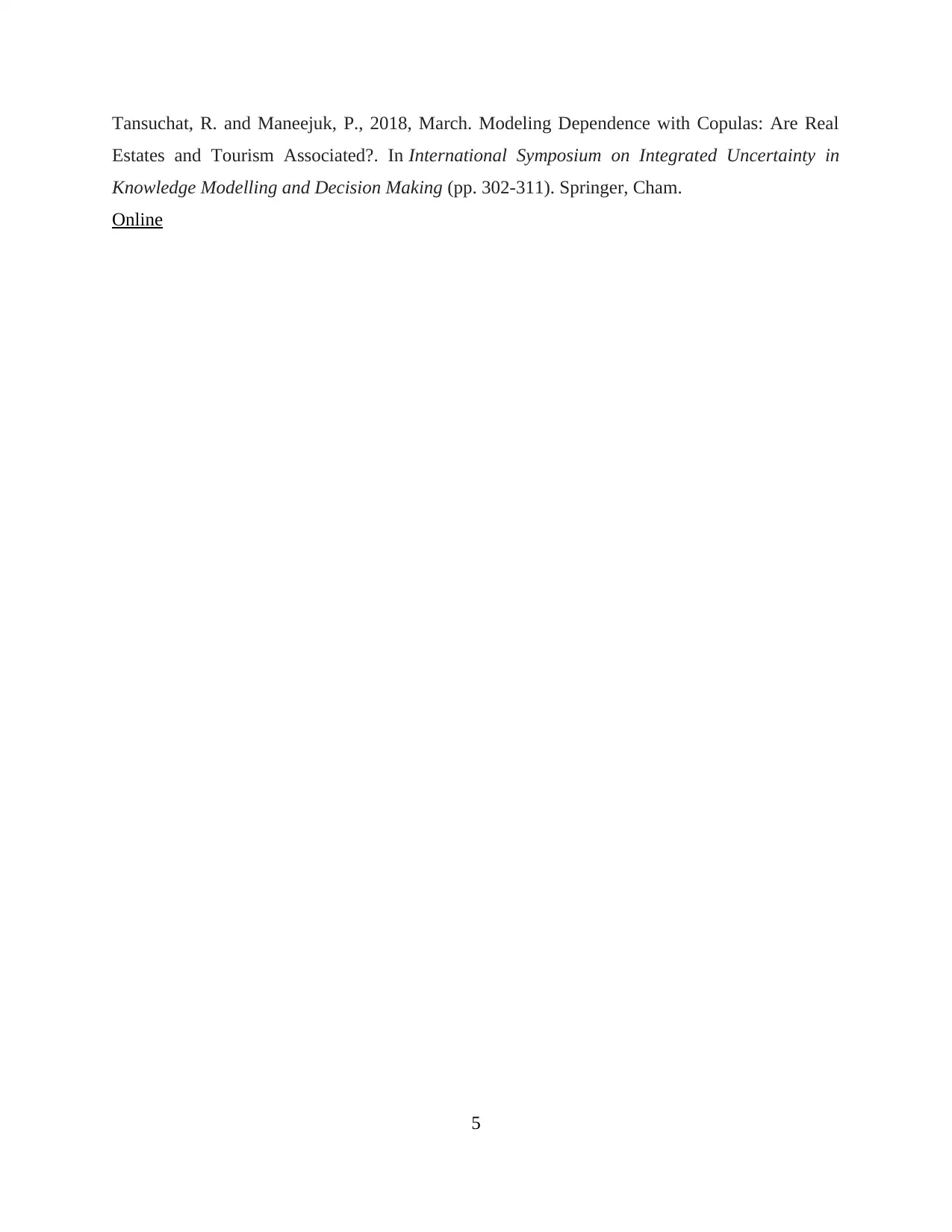Accounting Standards & Regulations: Investment Property Report
VerifiedAdded on 2020/07/23
|7
|1828
|55
Report
AI Summary
This report examines the valuation of investment properties, focusing on the Australian retail sector and its impact. It details accounting policies governed by AASB, particularly AASB 140, and discusses the fair value and cost models. The analysis includes the effects of changes in the retail industry on companies like Myer, David Jones, and others, alongside the economic consequences such as declining GDP and increased debt levels. The report emphasizes the importance of flexibility management in determining investment property values and concludes that the fair value model is the best method for measuring investment property value, predicting a rise in the Australian retail industry. The report also provides references to books, journals, and online resources.

Accounting Standards &
Regulations
Regulations
Paraphrase This Document
Need a fresh take? Get an instant paraphrase of this document with our AI Paraphraser

TABLE OF CONTENTS
INTRODUCTION...........................................................................................................................1
A) Summarising accounting policies relating to investment properties.................................1
B) Flexibility management in determination of investment property values.........................2
C) Potential impacts of changes in retail industry..................................................................2
D) Economic consequences of changes in retail industry......................................................3
CONCLUSION................................................................................................................................4
INTRODUCTION...........................................................................................................................1
A) Summarising accounting policies relating to investment properties.................................1
B) Flexibility management in determination of investment property values.........................2
C) Potential impacts of changes in retail industry..................................................................2
D) Economic consequences of changes in retail industry......................................................3
CONCLUSION................................................................................................................................4

INTRODUCTION
Investment property valuation plays important role in the business operating on large
basis. Present report deals with potential impacts of changes in the retail industry of VCX. It is
ASX listed real estate investment trust company which has analysed Australian retail sector in
the past recent years. Furthermore, accounting policies as governed by AASB are listed in this
report. These accounting policies help to assess clearly value of investment in the best possible
manner. Flexibility management is required to assess effectiveness of the financial statements so
that users of financial information may get adequate information.
A) Summarising accounting policies relating to investment properties
Accounting policies in the relation to investment properties are governed by AASB
(Australian Accounting Standards Board). It is the body which provides rules and regulations to
organisation. Australian retail industry is being changed drastically from the past years as
provided by ABS (Australian Bureau of Statistics). The major tenants in the retail sector are
Myer, David Jones, Oroton and Speciality Fashion Group. Furthermore, accounting policies are
quite important to companies regarding investment properties (Dungey, Yanotti and Wright,
2018). AASB 140 is provided by the board with reference to investment property. The standard
classify that investment property means that part of land held by the lessee under lease
agreement to earn rent money for capital appreciation.
Accounting policies are measurement at recognition, after recognition, fair value model
and cost model. The measurement at recognition implies that initial cost should be taken into
account while measuring investment property. Moreover, in initial cost, transactional costs
should also be included in calculating property in the best possible manner. Furthermore, amount
of liability should be recognised in the same. Measurement after recognition means that
exceptions are noted to choose fair value for all investment backing liabilities that pay return
linked to fair value of assets (Martin., 2018).
Fair value model implies that after initial recognition, this accounting policy can be
applied. Moreover, gain or loss arrived when change in fair value of investment property is
accomplished, then the same must be accounted in Profit or Loss for that period. Furthermore,
cost model means that business entity shall take into account AASB 116 requirements for the
1
Investment property valuation plays important role in the business operating on large
basis. Present report deals with potential impacts of changes in the retail industry of VCX. It is
ASX listed real estate investment trust company which has analysed Australian retail sector in
the past recent years. Furthermore, accounting policies as governed by AASB are listed in this
report. These accounting policies help to assess clearly value of investment in the best possible
manner. Flexibility management is required to assess effectiveness of the financial statements so
that users of financial information may get adequate information.
A) Summarising accounting policies relating to investment properties
Accounting policies in the relation to investment properties are governed by AASB
(Australian Accounting Standards Board). It is the body which provides rules and regulations to
organisation. Australian retail industry is being changed drastically from the past years as
provided by ABS (Australian Bureau of Statistics). The major tenants in the retail sector are
Myer, David Jones, Oroton and Speciality Fashion Group. Furthermore, accounting policies are
quite important to companies regarding investment properties (Dungey, Yanotti and Wright,
2018). AASB 140 is provided by the board with reference to investment property. The standard
classify that investment property means that part of land held by the lessee under lease
agreement to earn rent money for capital appreciation.
Accounting policies are measurement at recognition, after recognition, fair value model
and cost model. The measurement at recognition implies that initial cost should be taken into
account while measuring investment property. Moreover, in initial cost, transactional costs
should also be included in calculating property in the best possible manner. Furthermore, amount
of liability should be recognised in the same. Measurement after recognition means that
exceptions are noted to choose fair value for all investment backing liabilities that pay return
linked to fair value of assets (Martin., 2018).
Fair value model implies that after initial recognition, this accounting policy can be
applied. Moreover, gain or loss arrived when change in fair value of investment property is
accomplished, then the same must be accounted in Profit or Loss for that period. Furthermore,
cost model means that business entity shall take into account AASB 116 requirements for the
1
⊘ This is a preview!⊘
Do you want full access?
Subscribe today to unlock all pages.

Trusted by 1+ million students worldwide

model and not including other criteria which are held for sale. This should be done in accordance
to AASB 5 Non-current assets that includes assets held for sale and discontinued operations.
B) Flexibility management in determination of investment property values
The flexibility management is required in valuing investment property in the best
possible manner. This is required as retail industry of Australia has gone under significant
difference and as such, it is needed that accounting policies should be followed for greater
transparency (Woltering, Weis, Schindler. and Sebastian, 2018). Moreover, turnover can be
enhanced in a better way by complying with rules and concepts of accounting in relation to
measurement of investment property in the best possible manner. VCX (Vicinity Centres) which
is real estate investment trust organisation is impacted as the retail industry has undergone
changes. Lack of flexibility in investment property values have diminished quality information in
the financial statements of major retailers such as Myer, Oroton, David Jones and Speciality
Fashion Group quite adversely. Thus, flexibility is required to inculcate transparency in the
financial statements in the best possible manner.
For ensuring flexibility, it is required to assess whether property is used by business for
occupation or only use by that organisation. In relation to this, owner-occupied property is listed
in AASB 116 and investment property is listed in AASB 140 which is already discussed.
Moreover, fair value model represents true value of the investment property in effective manner.
Furthermore, applying fair value model will help retailers to implement flexibility and as such,
recipients of financial information may be able to assess the same in effectual way. On the other
hand, cost model is relevant to manufacturing sector which is not suitable for retail sector under
study. Thus, flexibility can be attained by implementing fair value model (Udawatta, George,
Elmualim, Rameezdeen and Zuo, 2018).
C) Potential impacts of changes in retail industry
There are major impact of changes in Australian retail industry. This is evident from the
fact that retail sector turnover has gone down in past years. The performance of David Jones is
decreased as it is evident from the annual report that gross profit margin has been negative in
past years. This means that expenses incurred on cost of sales are required to be controlled so
that gross profit may at least become positive. On the other hand, net profit is also lower down as
2
to AASB 5 Non-current assets that includes assets held for sale and discontinued operations.
B) Flexibility management in determination of investment property values
The flexibility management is required in valuing investment property in the best
possible manner. This is required as retail industry of Australia has gone under significant
difference and as such, it is needed that accounting policies should be followed for greater
transparency (Woltering, Weis, Schindler. and Sebastian, 2018). Moreover, turnover can be
enhanced in a better way by complying with rules and concepts of accounting in relation to
measurement of investment property in the best possible manner. VCX (Vicinity Centres) which
is real estate investment trust organisation is impacted as the retail industry has undergone
changes. Lack of flexibility in investment property values have diminished quality information in
the financial statements of major retailers such as Myer, Oroton, David Jones and Speciality
Fashion Group quite adversely. Thus, flexibility is required to inculcate transparency in the
financial statements in the best possible manner.
For ensuring flexibility, it is required to assess whether property is used by business for
occupation or only use by that organisation. In relation to this, owner-occupied property is listed
in AASB 116 and investment property is listed in AASB 140 which is already discussed.
Moreover, fair value model represents true value of the investment property in effective manner.
Furthermore, applying fair value model will help retailers to implement flexibility and as such,
recipients of financial information may be able to assess the same in effectual way. On the other
hand, cost model is relevant to manufacturing sector which is not suitable for retail sector under
study. Thus, flexibility can be attained by implementing fair value model (Udawatta, George,
Elmualim, Rameezdeen and Zuo, 2018).
C) Potential impacts of changes in retail industry
There are major impact of changes in Australian retail industry. This is evident from the
fact that retail sector turnover has gone down in past years. The performance of David Jones is
decreased as it is evident from the annual report that gross profit margin has been negative in
past years. This means that expenses incurred on cost of sales are required to be controlled so
that gross profit may at least become positive. On the other hand, net profit is also lower down as
2
Paraphrase This Document
Need a fresh take? Get an instant paraphrase of this document with our AI Paraphraser

it was 95 (Millions Austrialian Dollar) and decreased to 92 which is major downfall in the
financial year 2013.
Performance of Oroton has also lowered down in recent years. Furthermore, Myer's
performance is also come down as revenue was 2781 in 2016 while it was 2623 in next year
(Tansuchat and Maneejuk, 2018). This means that organisation is required to implement
structured strategies so that revenue may be increased in the best possible manner. On the other
hand, performance of Speciality Fashion Group which is big retailer in Australian market is also
lowered down. The revenue was 825 in 2016 while in 2017, it was reduced to 808. Thus, it is
required that strategies should be implemented for attaining good profits. The potential impact of
changes are technological impacts on retailer sector, reinvention and furthermore, online retail
sale mechanism has greater impact on the industry (Bruneau and Cherfouh., 2018). Thus, it can
be forecasted that retail sector will garner more profits in the coming years in effective way and
as such, losses can be covered with much ease.
D) Economic consequences of changes in retail industry
The economic consequences of changes in retail industry are numerous as highlighted by
the reports of VCX. The net income is reduced as it was 900 million in the financial year 2016
and in next year, net profit was around 650 million which is a major downfall. The economic
consequences may be declining of GDP (Gross Domestic Product) and as such, economic growth
will be impacted as well. Moreover, Australian economy is high cost economy relatively to other
economies of various nations. Macroeconomic effect can be seen on high retail expenditure
which will have impact on earnings.
Moreover, three are changes such as high debt levels, GFC (Global Financial Crisis) and
low purchasing power of customers and less spending are some of the major economic impacts
on economy of Australia. Furthermore, debt has also increased which is overall impacting
economy (Wong, Susilawati, Miller and Mardiasmo, 2018). The accounting theory states that
there are set of methodologies used for the purpose of financial accounting. Financial statements
are the key for preparing reports of the entity in the best possible manner. Income statement,
balance sheet and cash flow statement are three financials which form for the financial reporting.
The organisation prepares these statements and as such, this reporting is used for various
purpose. Mainly these are used by owners, creditors, investors and other parties which have stake
3
financial year 2013.
Performance of Oroton has also lowered down in recent years. Furthermore, Myer's
performance is also come down as revenue was 2781 in 2016 while it was 2623 in next year
(Tansuchat and Maneejuk, 2018). This means that organisation is required to implement
structured strategies so that revenue may be increased in the best possible manner. On the other
hand, performance of Speciality Fashion Group which is big retailer in Australian market is also
lowered down. The revenue was 825 in 2016 while in 2017, it was reduced to 808. Thus, it is
required that strategies should be implemented for attaining good profits. The potential impact of
changes are technological impacts on retailer sector, reinvention and furthermore, online retail
sale mechanism has greater impact on the industry (Bruneau and Cherfouh., 2018). Thus, it can
be forecasted that retail sector will garner more profits in the coming years in effective way and
as such, losses can be covered with much ease.
D) Economic consequences of changes in retail industry
The economic consequences of changes in retail industry are numerous as highlighted by
the reports of VCX. The net income is reduced as it was 900 million in the financial year 2016
and in next year, net profit was around 650 million which is a major downfall. The economic
consequences may be declining of GDP (Gross Domestic Product) and as such, economic growth
will be impacted as well. Moreover, Australian economy is high cost economy relatively to other
economies of various nations. Macroeconomic effect can be seen on high retail expenditure
which will have impact on earnings.
Moreover, three are changes such as high debt levels, GFC (Global Financial Crisis) and
low purchasing power of customers and less spending are some of the major economic impacts
on economy of Australia. Furthermore, debt has also increased which is overall impacting
economy (Wong, Susilawati, Miller and Mardiasmo, 2018). The accounting theory states that
there are set of methodologies used for the purpose of financial accounting. Financial statements
are the key for preparing reports of the entity in the best possible manner. Income statement,
balance sheet and cash flow statement are three financials which form for the financial reporting.
The organisation prepares these statements and as such, this reporting is used for various
purpose. Mainly these are used by owners, creditors, investors and other parties which have stake
3

in the business. Furthermore, they are able to take effective and better decisions by assessing
financial performance of the entity quite effectually.
CONCLUSION
Hereby it can be concluded that investment property is required to be measured in
effective way so that tenants may be able to extract correct value in the best possible manner. For
accomplishing this, accounting policies discussed above are quite helpful for measuring
investment property values with much ease. The Australian retail sector has gone under severe
changes and as such, whole economy is impacted quite adversely. Furthermore, various
economic consequences such as increasing debt levels, less spending of income by people has
impacted economy as a whole. Moreover, fair value model is regarded as the best method to
measure value of investment property. Thus, it can be said that Australian retail industry would
rise in the future as more retail sectors are operating in the nation.
REFERENCES
Books and Journals
Dungey, M., Yanotti, M. B. and Wright, D., 2018. Who, What, Where? Residential Property
Investment in Australia.
Martin, C., 2018. Clever Odysseus: narratives and strategies of rental property investor
subjectivity in Australia. Housing Studies. pp.1-25.
Woltering, R. O., Weis, C., Schindler, F. and Sebastian, S., 2018. Capturing the value premium–
global evidence from a fair value-based investment strategy. Journal of Banking & Finance. 86.
pp.53-69.
Udawatta, N., George, Z., Elmualim, A., Rameezdeen, R. and Zuo, J., 2018. Adaptive Reuse of
Inner-City Buildings: Methods for Minimising Waste and Stimulating the Economy.
In Proceedings of the 21st International Symposium on Advancement of Construction
Management and Real Estate(pp. 141-152). Springer, Singapore.
Bruneau, C. and Cherfouh, S., 2018. Modelling the asymmetric behaviour of property yields:
evidence from the UK office market. Journal of Property Research. 35(1). pp.1-27.
Wong, S. Y., Susilawati, C., Miller, W. and Mardiasmo, D., 2018. Improving information
gathering and distribution on sustainability features in the Australian residential property
market. Journal of Cleaner Production. 184. pp.342-352.
4
financial performance of the entity quite effectually.
CONCLUSION
Hereby it can be concluded that investment property is required to be measured in
effective way so that tenants may be able to extract correct value in the best possible manner. For
accomplishing this, accounting policies discussed above are quite helpful for measuring
investment property values with much ease. The Australian retail sector has gone under severe
changes and as such, whole economy is impacted quite adversely. Furthermore, various
economic consequences such as increasing debt levels, less spending of income by people has
impacted economy as a whole. Moreover, fair value model is regarded as the best method to
measure value of investment property. Thus, it can be said that Australian retail industry would
rise in the future as more retail sectors are operating in the nation.
REFERENCES
Books and Journals
Dungey, M., Yanotti, M. B. and Wright, D., 2018. Who, What, Where? Residential Property
Investment in Australia.
Martin, C., 2018. Clever Odysseus: narratives and strategies of rental property investor
subjectivity in Australia. Housing Studies. pp.1-25.
Woltering, R. O., Weis, C., Schindler, F. and Sebastian, S., 2018. Capturing the value premium–
global evidence from a fair value-based investment strategy. Journal of Banking & Finance. 86.
pp.53-69.
Udawatta, N., George, Z., Elmualim, A., Rameezdeen, R. and Zuo, J., 2018. Adaptive Reuse of
Inner-City Buildings: Methods for Minimising Waste and Stimulating the Economy.
In Proceedings of the 21st International Symposium on Advancement of Construction
Management and Real Estate(pp. 141-152). Springer, Singapore.
Bruneau, C. and Cherfouh, S., 2018. Modelling the asymmetric behaviour of property yields:
evidence from the UK office market. Journal of Property Research. 35(1). pp.1-27.
Wong, S. Y., Susilawati, C., Miller, W. and Mardiasmo, D., 2018. Improving information
gathering and distribution on sustainability features in the Australian residential property
market. Journal of Cleaner Production. 184. pp.342-352.
4
⊘ This is a preview!⊘
Do you want full access?
Subscribe today to unlock all pages.

Trusted by 1+ million students worldwide

Tansuchat, R. and Maneejuk, P., 2018, March. Modeling Dependence with Copulas: Are Real
Estates and Tourism Associated?. In International Symposium on Integrated Uncertainty in
Knowledge Modelling and Decision Making (pp. 302-311). Springer, Cham.
Online
5
Estates and Tourism Associated?. In International Symposium on Integrated Uncertainty in
Knowledge Modelling and Decision Making (pp. 302-311). Springer, Cham.
Online
5
1 out of 7
Related Documents
Your All-in-One AI-Powered Toolkit for Academic Success.
+13062052269
info@desklib.com
Available 24*7 on WhatsApp / Email
![[object Object]](/_next/static/media/star-bottom.7253800d.svg)
Unlock your academic potential
Copyright © 2020–2025 A2Z Services. All Rights Reserved. Developed and managed by ZUCOL.





